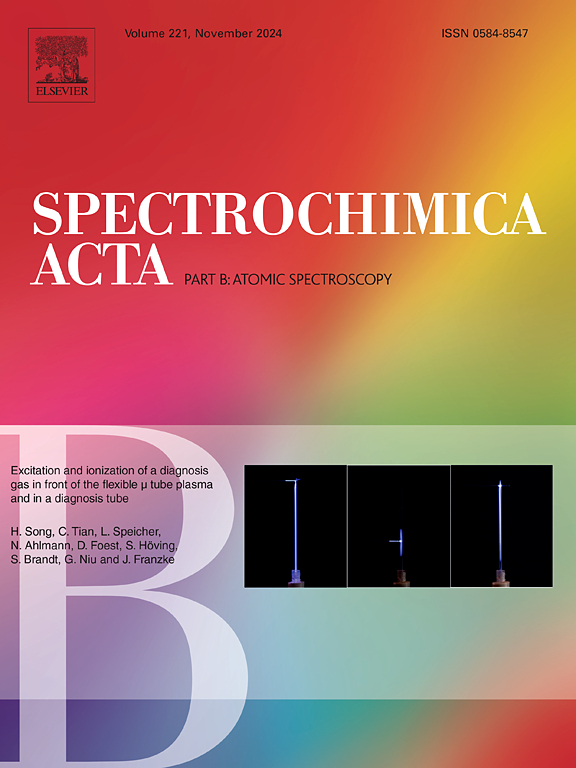Quantitative elemental analysis of magnesium alloys using calibration-cree femtosecond laser-ablation spark-induced breakdown spectroscopy (CF-fs-LA-SIBS)
IF 3.8
2区 化学
Q1 SPECTROSCOPY
引用次数: 0
Abstract
This work aimed to address the limitations of traditional methods in the elemental analysis of magnesium alloys. The femtosecond laser-ablation spark-induced breakdown spectroscopy (fs-LA-SIBS) technique combined with the calibration-free (CF) quantitative analysis method was employed. By optimizing experimental parameters, including discharge capacitance, voltage, resistance, laser single-pulse energy, and delay time, the spectral signal intensity and stability were enhanced. The limits of detection for various elements were determined. Through the CF method, the electron density and plasma temperature were calculated, and the quantitative analysis of multiple elements in standard magnesium alloy samples was carried out. The results showed relative errors within 30 % for most elements (e.g., Al: 3.9 %, Zn: 3.3 %), indicating high precision and stability in the elemental analysis of magnesium alloys.

使用校准-cree飞秒激光烧蚀火花诱导击穿光谱(CF-fs-LA-SIBS)定量分析镁合金元素
这项工作旨在解决传统方法在镁合金元素分析中的局限性。采用飞秒激光烧蚀火花诱导击穿光谱(fs-LA-SIBS)技术结合无标定(CF)定量分析方法。通过优化实验参数,包括放电电容、电压、电阻、激光单脉冲能量和延迟时间,增强了光谱信号的强度和稳定性。测定了各种元素的检出限。通过CF法计算电子密度和等离子体温度,并对标准镁合金样品中多种元素进行定量分析。结果表明,大多数元素(Al: 3.9%, Zn: 3.3%)的相对误差在30%以内,表明镁合金元素分析具有较高的精度和稳定性。
本文章由计算机程序翻译,如有差异,请以英文原文为准。
求助全文
约1分钟内获得全文
求助全文
来源期刊
CiteScore
6.10
自引率
12.10%
发文量
173
审稿时长
81 days
期刊介绍:
Spectrochimica Acta Part B: Atomic Spectroscopy, is intended for the rapid publication of both original work and reviews in the following fields:
Atomic Emission (AES), Atomic Absorption (AAS) and Atomic Fluorescence (AFS) spectroscopy;
Mass Spectrometry (MS) for inorganic analysis covering Spark Source (SS-MS), Inductively Coupled Plasma (ICP-MS), Glow Discharge (GD-MS), and Secondary Ion Mass Spectrometry (SIMS).
Laser induced atomic spectroscopy for inorganic analysis, including non-linear optical laser spectroscopy, covering Laser Enhanced Ionization (LEI), Laser Induced Fluorescence (LIF), Resonance Ionization Spectroscopy (RIS) and Resonance Ionization Mass Spectrometry (RIMS); Laser Induced Breakdown Spectroscopy (LIBS); Cavity Ringdown Spectroscopy (CRDS), Laser Ablation Inductively Coupled Plasma Atomic Emission Spectroscopy (LA-ICP-AES) and Laser Ablation Inductively Coupled Plasma Mass Spectrometry (LA-ICP-MS).
X-ray spectrometry, X-ray Optics and Microanalysis, including X-ray fluorescence spectrometry (XRF) and related techniques, in particular Total-reflection X-ray Fluorescence Spectrometry (TXRF), and Synchrotron Radiation-excited Total reflection XRF (SR-TXRF).
Manuscripts dealing with (i) fundamentals, (ii) methodology development, (iii)instrumentation, and (iv) applications, can be submitted for publication.

 求助内容:
求助内容: 应助结果提醒方式:
应助结果提醒方式:


